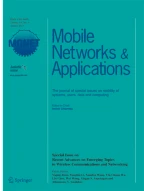Abstract
Services for mobile and pervasive computing should extensively exploit contextual information both to adapt to user needs and to enable autonomic behavior. To fulfill this idea it is important to provide two key tools: a model supporting context-data representation and manipulation, and a set of algorithms relying on the model to perform application tasks. Following these lines, we first describe the W4 context model showing how it can represent a simple yet effective framework to enable flexible and general-purpose management of contextual information. In particular, we show the model suitability in describing user-centric situations, e.g., describing situations in terms of where a user is located and what he is doing. Then, we illustrate a set of algorithms to semantically enrich W4 represented data and to extract relevant information from it. In particular, starting from W4 data, such algorithms are able to identify the places that matter to the user and to describe them semantically. Overall, we show how the context-model and the algorithms allow to create an high-level, semantic and context-aware diary-based service. This service meaningfully collects and classifies the user whereabouts and the places that the user visited.
Similar content being viewed by others
References
Abdelzaher T, Anokwa Y, Boda P, Burke J, Estrin D, Guibas L, Kansal A, Madden S (2007) Mobiscopes for human spaces. IEEE Pervasive Comput 6(2):20–29
Ahuja S, Carriero N, Gelernter D (1986) Linda and friends. IEEE Comput 19(8):26–34
Ashbrook D, Starner T (2003) Using GPS to learn significant locations and predict movement across multiple users. Personal Ubiquitous Comput 7(1):275–286
Bannach D, Lukowicz P, Amft O (2008) Rapid prototyping of activity recognition applications. IEEE Pervasive Comput 7(2):22–31
Bicocchi N, Castelli G, Mamei M, Rosi A, Zambonelli F (2008) Supporting location-aware services for mobile users with the whereabouts diary. Int Conf Mobile Wireless Middleware, Operating Syst Appl, Innsbruck, Austria
Bravo J, Hervas R, Chavira G, Nava S (2006) Modeling contexts by RFID-sensor fusion. Conf Pervasive Comput Commun Workshops, Pisa, Italy
Castelli G, Rosi A, Mamei M, Zambonelli F (2007) A simple model and infrastructure for context-aware browsing of the world. Int Conf Pervasive Comput Commun, White Plains, NY, USA
Dey AK, Abowd GD, Salber D (2001) A conceptual framework and a toolkit for supporting the rapid prototyping of context-aware applications. Hum-Comput Interact 16(2–4):97–166
Fitzgerald M (2004) Your digital wallet. MIT Technology Review, 24 August
Hahnel D, Burgard W, Fox D, Fishkin K, Philipose M (2004) Mapping and localization with RFID technology. IEEE Int Conf Robotics and Autom, New Orleans (LA), USA
Henricksen K, Indulska J, Rakotonirainy A (2006) Developing context-aware pervasive computing applications: Models and approach. J Perv Mobile Comput 2(1):37–64
Hightower J (2003) From position to place. Workshop on Location-Aware Computing, Seattle, WA, USA
Hightower J, Consolvo S, LaMarca A, Smith I, Hughes J (2005) Learning and recognizing the places we go. Int Conf on Ubiquitous Comput, Tokyo, Japan
Hong J (2002) The context fabric: An infrastructure for context-aware computing. Conf Comput Human Interaction, Minneapolis, MN, USA
Julien C, Roman G (2006) EgoSpaces: Facilitating rapid development of context-aware mobile applications. IEEE Trans Softw Eng 32(5):281–298
Kang J, Welbourne W, Stewart B, Borriello G (2004) Extracting places from traces of locations. Int Workshop on Wireless Mobile Appl Services on WLAN Hotspots, Philadelphia, PA, USA
Liu H, Singh P (2004) ConceptNet: a practical commonsense reasoning toolkit. BT Technol J 22(4):211–226
Lenat D, Guha RV (1990) Building large knowledge-based systems: Representation and Inference in the Cyc Project. Addison-Wesley, New York
Mamei M, Nagpal R (2007) Macro programming through bayesian networks: Distrib Inference Anomaly Detection, Int Conf Pervasive Comput Commun, White Plains, NY, USA
Marmasse N, Schmandt C (2000) Location-aware information delivery with commotion. Int Symp Handheld and Ubiquitous Comput, Bristol, UK
Newman W, Eldridge M, Lamming M (1991) PEPYS: Generating autobiographies by automatic tracking. European Conf Computer Supported Cooperative Work, Amsterdam, The Netherlands
Paskin M, Guestrin C, McFadden J (2005) A robust architecture for inference in sensor networks. Int Symp Information Processing in Sensor Networks, Los Angeles, CA, USA
Patterson D, Liao L, Fox D, Kautz H (2003) Inferring high-level behavior from low-level sensors. Int Conf Ubiquitous Comput, Seattle, WA, USA
Patterson D, Liao L, Gajos K, Collier M, Livic N, Olson K, Wang S, Fox D, Kautz H (2004) Opportunity knocks: A system to provide cognitive assistance with transportation services. International Conference on Ubiquitous Computing, Nottingham, UK
Philipose M, Fishkin K, Perkowitz M, Patterson D, Fox D, Kautz H, Hahnel D (2004) Inferring activities from interactions with objects. IEEE Perv Comput 3(4):50–57
Riva O, Borcea C (2007) The urbanet revolution: Sensor power to the people. IEEE Perv Comput 6(2):44–44
Schmid F, Richter K (2006) Extracting places from location data streams. International Workshop on Ubiquitous Geographical Information Services, Munster, Germany
Schmidt A, Aidoo KA, Takaluoma A, Tuomela U, Van Laerhoven K, Van de Velde W (1999) Advanced interaction in context. Symposium on Handheld and Ubiquitous Computing, Karlsruhe, Germany
Schilit B, Adams N, Want R, Context-aware computing applications. Workshop
Twitter: What are you doing? http://Twitter.com
Xu C, Cheung SC (2005) Inconsistency detection and resolution for context-aware middleware support. Symposium on the Foundations of Software Engineering, Lisbon, Portugal
Acknowledgements
Work supported by the project CASCADAS (IST-027807) funded by the FET Program of the European Commission.
Author information
Authors and Affiliations
Corresponding author
Rights and permissions
About this article
Cite this article
Castelli, G., Mamei, M., Rosi, A. et al. Extracting High-Level Information from Location Data: The W4 Diary Example. Mobile Netw Appl 14, 107–119 (2009). https://doi.org/10.1007/s11036-008-0104-y
Published:
Issue Date:
DOI: https://doi.org/10.1007/s11036-008-0104-y
